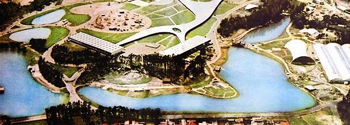THE IBIRAPUERA LAKES AS HYDRIC STRUCTURE OF A PARK
DOI:
https://doi.org/10.11606/issn.2179-2275.v1i10p156-167Keywords:
Architecture, Lake, Ibirapuera Park, Water Structure, LandscapingAbstract
This article aims to achieve a different analysis of the most visited urban park in the city of São Paulo, having its water as reference. By analyzing texts from different authors, it was noted that there are many reports of the history of that park, from its conception, through its implementation until the current situation. It was also found critical analyzes approaching several issues such as politics, architecture, landscaping, use of spaces by users etc. However, a little was found about the lakes and its relationship with the conception design of the park, but just historical files with records of various projects to clean up pollution its waters. This work intends to clarify how the implementation and use of the Ibirapuera area has occurred – and still occurs – according to the needs of the society. It also intends to explain how the relationship of the society with the local landscape is. How has occurred the transformation of a large ecological area in an urban park, built to symbolize progress? Which is the role of those lakes in the structure of the park? Which are the processes involved in the transformation of that area? How are the lakes considered by its users and how the relationship between people and the lakes is? These and other questions will be answered by the results of bibliographic search, official files and also through analysis and visits to that site, as well as interviews with researchers and park staff.Downloads
References
ANDRADE, Manuella Marianna Carvalho Rodrigues de. O Processo Histórico de Formação do Parque do Ibirapuera. São Paulo: Departamento do Patrimônio Histórico – Divisão do Arquivo Histórico Municipal “Washington Luís”.
BARONE, Ana Claudia Castilho. Ibirapuera: parque metropolitano (1926-1954). São Paulo: FAUUSP, 2007. (Tese de doutorado).
BARTALINI, Vladmir. Parques públicos municipais de São Paulo: a ação da municipalidade no provimento de áreas verdes de recreação. São Paulo: FAUUSP, 1999. (Tese de doutorado).
LOBODA, Carlos Roberto; ANGELIS, Bruno Luiz Domingos de. Áreas Verdes Públicas Urbanas: Conceitos, Usos e Funções.
LOFEGO, Silvio Luiz. IV Centenário da Cidade de São Paulo: uma cidade entre o passado e o futuro. São Paulo: Annablume, 2004.
LOVELOCK, James. As Eras de Gaia, uma biografia do nosso planeta vivo. Portugal: Publicações Europa América Ltda., 1989.
MARIANO, Cassia. Preservação e Paisagismo em São Paulo: Otávio Augusto Teixeira Mendes. São Paulo: Annablume, Fapesp, Fundação Maria Luisa e Oscar Americano, 2005.
MOSES, Robert. Programa de melhoramentos públicos para a cidade de São Paulo. Revista do Instituto de Engenharia, São Paulo, n. 103, v. 5, mar. 1951, p. 321-7.
ODUM, Eugene P. Fundamentos de Ecologia. Lisboa: Fundação Calouste Gulbekian, 1976.
OLIVEIRA, Fabiano Lemes de. O Parque do Ibirapuera: projetos, modernidades e modernismos. DOCOMOMO_5, São Paulo, 2014.
OLIVEIRA, Fabiano Lemes. Projetos para o Parque do Ibirapuera: de Manequinho Lopes a Niemeyer (1926-1954). São Paulo, 2003. (Dissertação de Mestrado).
SEGAWA, Hugo. Ao amor do público: jardins no Brasil. São Paulo: Studio Nobel; FAPESP, 1996. (Cidade aberta).

Downloads
Published
Issue
Section
License
O detentor dos direitos autorais é o autor e eventuais coautores do artigo. A Revista LABVERDE exige apenas o ineditismo na publicação do artigo. O autor tem o direito de divulgar seu artigo conforme sua conveniência devendo citar a revista.
A Revista LABVERDE autoriza a republicação de seus artigos desde que devidamente citada fonte e autoria.


